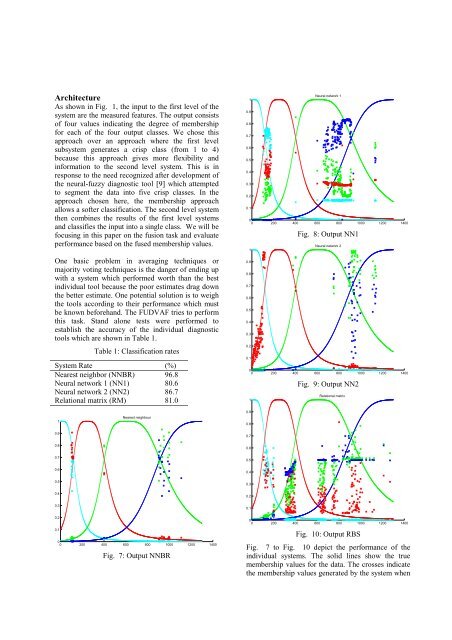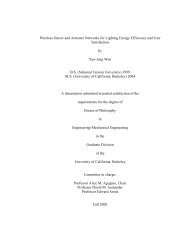Diagnostic Information Fusion for Manufacturing Processes
Diagnostic Information Fusion for Manufacturing Processes
Diagnostic Information Fusion for Manufacturing Processes
You also want an ePaper? Increase the reach of your titles
YUMPU automatically turns print PDFs into web optimized ePapers that Google loves.
Architecture<br />
As shown in Fig. 1, the input to the first level of the<br />
system are the measured features. The output consists<br />
of four values indicating the degree of membership<br />
<strong>for</strong> each of the four output classes. We chose this<br />
approach over an approach where the first level<br />
subsystem generates a crisp class (from 1 to 4)<br />
because this approach gives more flexibility and<br />
in<strong>for</strong>mation to the second level system. This is in<br />
response to the need recognized after development of<br />
the neural-fuzzy diagnostic tool [9] which attempted<br />
to segment the data into five crisp classes. In the<br />
approach chosen here, the membership approach<br />
allows a softer classification. The second level system<br />
then combines the results of the first level systems<br />
and classifies the input into a single class. We will be<br />
focusing in this paper on the fusion task and evaluate<br />
per<strong>for</strong>mance based on the fused membership values.<br />
One basic problem in averaging techniques or<br />
majority voting techniques is the danger of ending up<br />
with a system which per<strong>for</strong>med worth than the best<br />
individual tool because the poor estimates drag down<br />
the better estimate. One potential solution is to weigh<br />
the tools according to their per<strong>for</strong>mance which must<br />
be known be<strong>for</strong>ehand. The FUDVAF tries to per<strong>for</strong>m<br />
this task. Stand alone tests were per<strong>for</strong>med to<br />
establish the accuracy of the individual diagnostic<br />
tools which are shown in Table 1.<br />
Table 1: Classification rates<br />
System Rate (%)<br />
Nearest neighbor (NNBR) 96.8<br />
Neural network 1 (NN1) 80.6<br />
Neural network 2 (NN2) 86.7<br />
Relational matrix (RM) 81.0<br />
1<br />
0.9<br />
0.8<br />
0.7<br />
0.6<br />
0.5<br />
0.4<br />
0.3<br />
0.2<br />
0.1<br />
0<br />
0 200 400 600 800 1000 1200 1400<br />
1<br />
0.9<br />
0.8<br />
0.7<br />
0.6<br />
0.5<br />
0.4<br />
0.3<br />
0.2<br />
0.1<br />
Neural network 1<br />
Fig. 8: Output NN1<br />
0<br />
0 200 400 600 800 1000 1200 1400<br />
1<br />
Neural network 2<br />
Fig. 9: Output NN2<br />
Relational matrix<br />
1<br />
Nearest neighbour<br />
0.9<br />
0.8<br />
0.9<br />
0.7<br />
0.8<br />
0.6<br />
0.7<br />
0.5<br />
0.6<br />
0.4<br />
0.5<br />
0.3<br />
0.4<br />
0.2<br />
0.3<br />
0.1<br />
0.2<br />
0.1<br />
0<br />
0 200 400 600 800 1000 1200 1400<br />
Fig. 7: Output NNBR<br />
0<br />
0 200 400 600 800 1000 1200 1400<br />
Fig. 10: Output RBS<br />
Fig. 7 to Fig. 10 depict the per<strong>for</strong>mance of the<br />
individual systems. The solid lines show the true<br />
membership values <strong>for</strong> the data. The crosses indicate<br />
the membership values generated by the system when
















